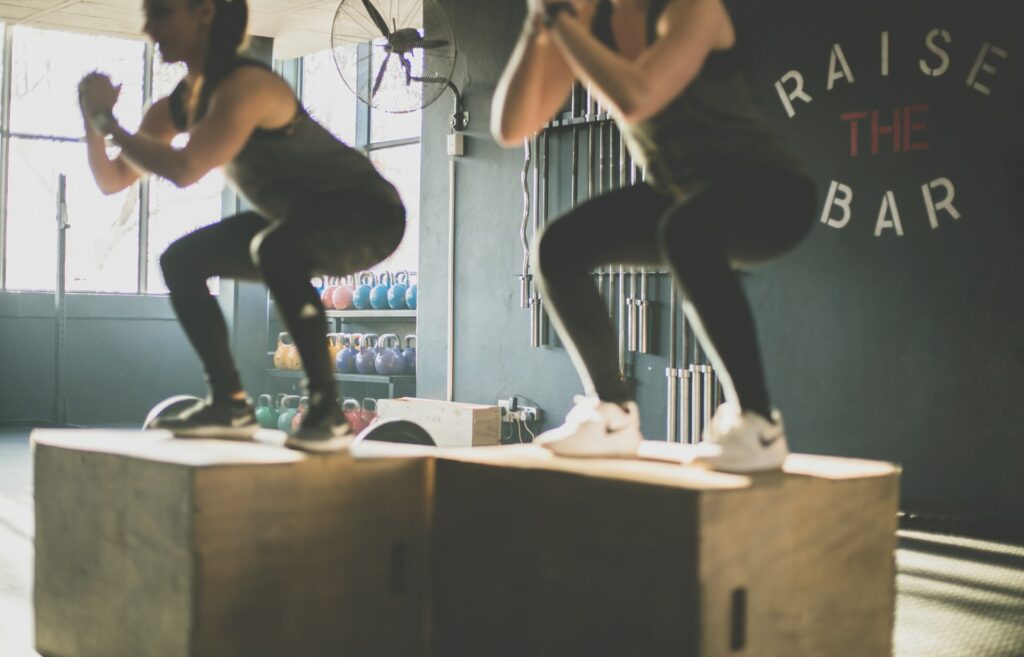Last Updated on March 15, 2024
Knee pain commonly occurs when muscles, tendons, or ligaments that surround the knee are experiencing inflammation or are injured. This pain is prevalent among teenagers, young adults, athletes, and those experiencing arthritic pain.
Below are the top exercises and stretches you can do at home to help strengthen or relax key muscles to help address knee pain. However, if you are experiencing moderate-to-severe knee pain or experiencing internal knee pain, it is essential to seek professional care from an experienced chiropractor or acupuncturist.
Related: 4 Tips to Prevent Injuries for Runners
Hip Abduction
Whether you’re an athlete or not, there is a correlation between weak gluteal muscles and knee pain, specifically the muscles that control the abduction of the hip. To strengthen this muscle group, do the following exercise:
Lie on your side with the upside leg straightened. Rotate your hip inwards (think of pointing your toe to the ground) and then slowly raise your leg towards the ceiling or sky. The key here is slow, controlled movements. Your leg should be aligned with your back and pelvis, not in front or behind your center of gravity. Perform three sets of 10-16 repetitions for each leg.
Straight-leg-raise
The next muscle group we need to strengthen for general knee pain are the quadriceps, the thigh muscles that contract when we completely straighten our leg. This muscle group directly connects to the kneecap via a large tendon and is prone to elicit pain when weak, tight, or irritated.
This exercise will help activate and reinforce the quadriceps without putting an excess load on the muscle:
Lie on your back in a supine position with the leg being exercised straightened on the ground and the other bent in a relaxed position. Now slowly raise the target leg as far as comfortable without lifting your glutes off the ground, and then slowly lower your leg back to the ground, do 3×10-16 for each leg. You can increase the difficulty of this exercise by holding a glute bridge during the exercise.
Foam Rolling
Implementing a self-massage or muscle release routine is a great way to help relax tight, irritated muscles experiencing inflammation. Easy tools for doing this include a foam roller.
For knee pain, I recommend targeting the hamstrings, quads, and calves with the foam roller until tension release is felt — setting a time limit of 3-5 minutes for each muscle group. Rolling these muscles on a lacrosse ball can offer a more targeted session.
Hamstring and Psoas Stretching
Two key muscle groups that connect to the knee and can cause pain are the larger thigh muscles. Stretching these muscles out can help reduce tension and improve the range of motion. You can hold these stretches 3x 45-90s at a time or do 15 short 5-10s holds.
Hamstring stretch: Sit on the floor with both legs straight and reach out with your hands as far as feels comfortable. Alternatively, stand upright, cross one leg over the other, keep both legs straight, then slowly bring your forehead down towards your knees by bending at the waist and rounding out the lower back.
Psoas stretch: Start with both knees on the ground and lunge forward with your left leg so your left foot and right knee make contact with the ground. Slowly lunge forward while keeping your back straight, hold for the desired time, and then repeat for the other side. You can increase the stretch by squeezing your glute muscles when leaning into the lunge.

Swimming
If you’re looking to get your heart rate up and boost your endorphins, try swimming for knee pain. Swimming is one of the best workouts for knee pain, as it allows you to exercise without putting added stress on your body.
In addition to helping with knee pain, swimming can help you improve your range of motion, stretch out your joints, and improve your body’s circulation. Plus, swimming is excellent for your mental health and can relieve stress. If you get bored of swimming laps, you can also try water aerobics for knee pain.
Yoga
Yoga is another fantastic low-impact exercise for knee pain. Doing yoga can reduce symptoms of chronic pain while simultaneously improving mobility, fitness, and your overall quality of life. Yoga can also help with mindfulness. Here are some yoga poses you can try for knee pain:
Bridge Pose
The bridge pose can soothe knee pain while strengthening your knee. Lie on your back with your legs bent and place a yoga block between your thighs. Slowly lift your buttocks off the ground as you squeeze the yoga block with your inner thighs. Hold at the top for about ten seconds before lowering back down.
You should feel this move in your glutes, hamstrings, and quads.
Banana Pose
The banana pose involves opening the hip so tension releases from the pelvis downward. Lie on your yoga mat, cross one ankle over the other, and hold your arms out behind you. Then, slowly stretch your upper body by moving it toward one side of the mat.
Repeat the pose on the other side until you feel stretched and relaxed.
Warrior Pose
The warrior pose is a classic yoga pose, and it’s one of the first poses many people learn when starting their yoga journey. The pose can help with strength and alignment so you can improve your knees.
Step one foot in front of the other and bend your front leg at a 90-degree angle. Keep your weight centered on your front leg’s heel, and keep both heels and toes on the floor. Try to keep your shoulders square and your body facing forward. Then, slowly raise your arms toward the sky. Breathe in and out a few times before lowering your arms back down.
You can reach one arm forward and one arm back to perform the warrior pose.
Hero Pose
Sit on your yoga block with your knees tucked under your butt to perform the hero pose. Allow yourself to rest atop the block as you relax your hips and experience a stretch through your quads, knees, and ankles. Stay in this pose for about a minute as you slowly breathe in and out.
Related: How to Start a Meditation Practice

Half Squat
Moving your body into a full squat can be difficult if you’re experiencing knee pain. However, doing half squats can strengthen your knees, as well as your quads, glutes, and hamstrings.
Stand with your feet shoulder-width apart to perform a half squat. Then, reach your hands out in front of you or place them on your hips. Slowly lower your body by about 10 inches while looking straight ahead.
Pause for a few seconds and then return to the standing position. You can repeat this for a minute or do 3 sets of 10 repetitions.
Calf Raises
Your calves support your knees, so it’s important to have strong calves to prevent and recover from knee pain. Stand with your feet shoulder-width apart to perform a calf raise.
You can position yourself next to a wall or place one hand on a chair if you find it difficult to balance. Slowly lift your heels off the ground until you’re standing on the balls of your feet. Then, slowly lower yourself to the starting position.
Stay controlled in your movement, and repeat the exercise for 3 sets at 10 reps each.
Side Leg Raise
In addition to straight leg raises, side leg raises can help with knee pain. Lie on your side and stack your legs to perform a side leg raise. You can either hold your arm out and lie your head down on top of it, or you can prop your head up with your arm and place your other arm in front of you.
Then, slowly raise your top leg, reaching it as high as you comfortably can. You should feel the movement in your hips and quads. Take a brief pause at the top, then slowly lower your leg back to the starting position.
Click here to learn who you should see when you’re in pain!
Prone Leg Raise
Prone leg raises work your glutes and hamstrings and strengthen your knees. Lie on your stomach (we recommend placing a mat below you for cushioning). Place your legs straight behind you and allow your head to rest on your arms.
Slowly lift one leg off the floor as high as you comfortably can. Remember to keep your hamstrings and glutes engaged and keep your pelvic bone on the floor. Keep your leg lifted high for a few seconds, then slowly lower it down.
Heel and Calf Stretch
Stretching your calves and heels ensures your legs and knees stay flexible. Face a wall and place your hands against it. Then, step one foot back and lean forward as far as you can comfortably go. Keep your heels flat and your toes facing forward and slightly bend your front knee. Hold the stretch for about 30 seconds before switching sides.
Quad Stretch
Your quads play a vital role in keeping your legs and body strong. Stretching your quads after you exercise will ensure you stay flexible and healthy. Place your feet shoulder-width apart and lift one leg off the ground, bending the knee until your heel touches your buttocks. Grab your ankle and hold onto a wall or chair for support if you need to.
Hold the stretch for about 30 seconds before switching legs.
Related: What are Shin Splints?
Time to Combat Knee Pain
There are many excellent stretches and exercises for combatting knee pain. Now, it’s time for you to give these movements a try.
We also recommend seeing a chiropractor, acupuncturist, or massage therapist for extra help with your knee pain.
Fill out Inner Gate’s new patient form to get started!


Thank you for sharing this information. Your blog will really help me.
Great Post! It’s crucial to start any new exercise or stretching routine slowly and gently. If you experience increased pain or discomfort, stop the activity and consult a healthcare professional. Additionally, maintaining a healthy weight, wearing proper footwear, and using knee supports when necessary can also contribute to managing knee pain during exercises and daily activities.